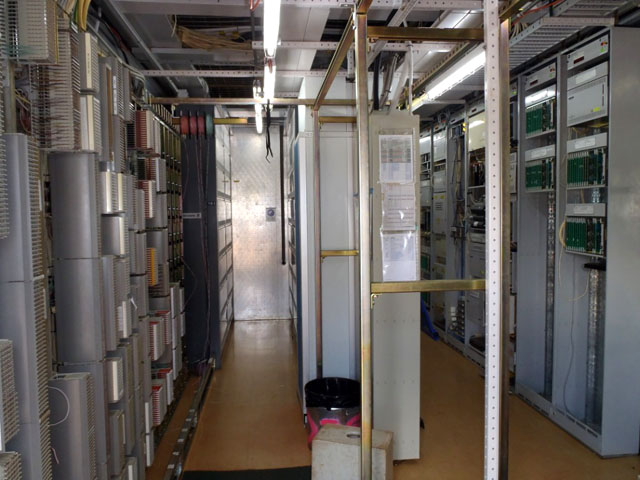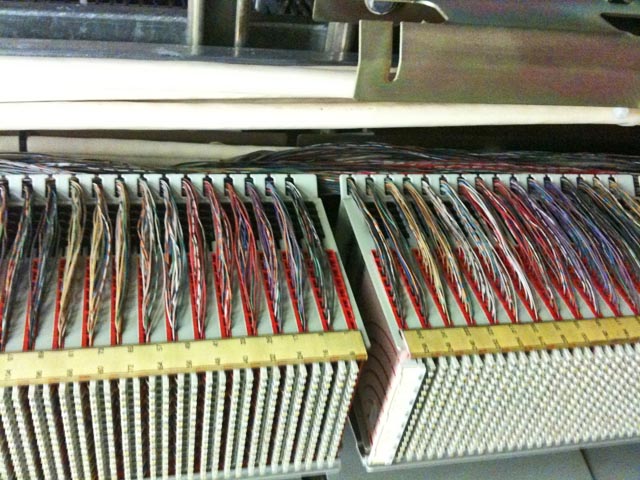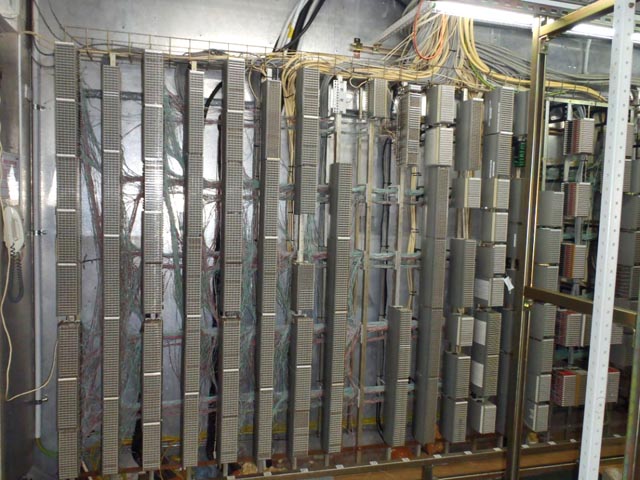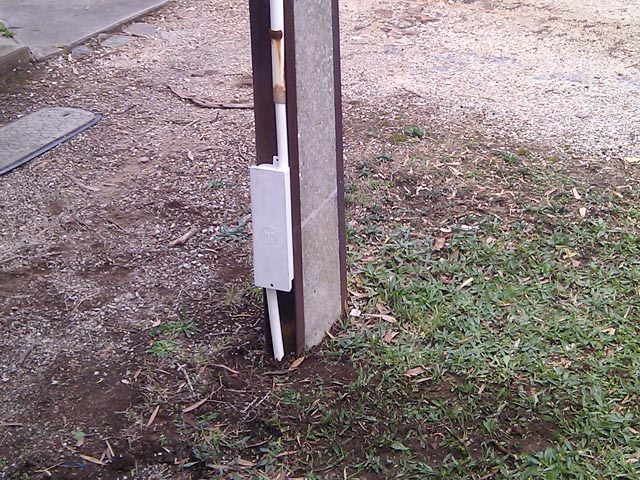Following our publication of a photo gallery of “worst of the worst” photos of Telstra’s copper network, the telco declined our challenge to provide photos of pristine, well-maintained infrastructure. So, we sourced our own photos anyway.
The following photos were sent in by a number of readers over the past few weeks who wanted to show the other side of Telstra’s copper telecommunications network. It’s not all degradation and disaster out there, as these photos of well-maintained telephone exchanges show. Not much of it looks very ‘modern’, but it’s all functioning, clean, well-maintained equipment in good order. If you’ve got any more photos of well-maintained Telstra infrastructure, send the shots in to renai@delimiter.com.au and we’ll add them to this gallery.
In addition, you may remember this photo below from our ‘worst of the worst’ gallery. Well, following the publication of that gallery, Telstra sent its maintenance team out to this location and fixed this issue. So what we have here is a ‘before’ photo:
And this is the same location, after Telstra’s team cleaned it up. Not bad!
Image credit: Various







The thing to remember though is the chain (of communication links) is only as strong as its weakest link.
Exactly what I was thinking as I read this. My car has got a fantastick new radiator, pity the rest of it is rusting with a cracked head, shot suspension and worn brakes.
Can we get a photo of what an exchange will look like once its built to NBN standards? I suggest it will be far smaller, and simpler.
I have asked NBN Co for some photos of their own network infrastructure — this may help.
I’d swear there were countless numbers of images available on the NBNCo website? The ‘blog’ seems to regularly list images of the rollout in progress and I’m certain I’ve seen some inside ‘exchanges’.
I believe it is fairly rare to have many “faults” occur in the exchange. Faults generally occur out in the field and the previous photo’s showed this. If the network in the field was kept this clean, maybe we wouldn’t have this article.
I think where Delimiter was going with this story is – with an NBN with FTTN infrastructure(Liberal policy), the issue of an ancient, poorly maintained copper network in the field would still be a major issue, but a FTTH will upgrade this infrastructure and reduce faults in the network dramatically!
As much as I hate to admit it, Schmoo is right.
FTTN would upgrade the infrastructure in the exchange, the links to the nodes and probably a lot of the old crap along the way.
That said, most of the awful copper horror is in the last mile and most of that wouldn’t be touched unless people complained incessantly.
And as time goes by ……. the nice new shiny Fibre will look no different to today’s cables, probably suffering similar issues (performance wise), not delivering the service intended, particularly if the same people are let loose in the field.
Not true I’m afraid Frank.
That’s where the NBN REALLY one-ups copper. Copper requires only the barest of connections to continue working- sure, it may not work well, as so many people have attested too, but it works. Fibre on the other hand…
Fibre’s advantage is the fact that it must have a perfect connection to work correctly. If external light gets in the pipe, mostly, it won’t interfere, as the laser-like light beam cuts through it. But if the pipe is damaged? The light beam hits the impurity/crack….and stops dead. No connection.
Copper has served us well, but we need to move on. The NBN will fix many issues regarding our telecommunications infrastructure, one of them being degraded connection quality.
Nope, Frank. Telstra rates its in-ground copper as having a 30-year effective life. British Telecom rates its in-ground fibre as having an effective life of up to a century.
Gel-filled tubes protect the fibre, which is of course non-metallic and non-reactive to chemicals. Apart from a backhow going through it, nothing much goes wrong with fibre over time, hence its choice over anything else.
It wasn’t that long ago I removed some copper cable to allow for a new building to be erected. When it was removed it was in a dry spell, yet the sheath was quite wet when removed. This tended to indicate the cable had been immersed in water for some time. Indications were that the cable was installed in the mid 70s . As such I decide to cut the cable into sections and inspect it’s condition, especially where the sheath indicated it had been in water for long periods.
Upon inspection it was found to have no moisture barrier (grease) and had a manufacture tracer of 1972. Stripping back the insulation of various conductors showed no signs any deterioration of the cable or its conductors and looked as good a new cable would today.
This would suggest cables just don’t deteriorate because of age to any great extent, at least not PVC type cables, (lead cables with paper insulated conductors maybe a different matter).
So what causes cables to deteriorate or impede their performance? I would put this into 3 main categories.
1. Incompetent Telstra Staff or Contractors not doing their job correctly. Failing to close/seal joints correctly and shoddy workmanship. Some of the pictures in the list of poor cabling without doubt shows this to be the case.
If these same people are allowed to be let loose in the NBN and bring their habits with them then there are long term risks to the optic fibre cable. No, since there is no current flowing in the cable there will be no corrosion problems like copper, but the ingress of water and contaminates may have a long term impact on the individual fibres.
2. Vandalism – This currently happens, cables cut in pits etc. Just because fibre is installed with the NBN won’t stop this from happening in the future. In fact it may be more of a risk as Fibre cables are much smaller and be much easier to cut/damage.
3. Natural Disasters – The picture of the damaged RIM due to flooding brings this to mind. Fibre will be terminated and distributed in roadside cabinets. The fact that it is now fibre terminating in them doesn’t make them immune from ingress of water due to a natural event like flooding.
I think you are pissing into the wind if you think fibre won’t be affected in similar ways to copper (metallic) cable products in the future. One only has to read the number of times a ULL connection is disconnected and the excuse is there was no dial tone. If these same people are allowed loose in a fibre network where there is no dial tone to identify a service, how on earth could they get it right on a fibre service due to their high level of incompetence.
Yes I stand by original statement that in the end the performance of Optic Fibre will depend on who is let loose on the network and that current Telstra staff and contractors should be kept well away from it. Bad habits of people are hard to identify in the short term, but will have a long lasting effect on the integrity of the network, much the same as the current Telstra copper network. (Without doubt most of the current issues in the current Telstra network is the result of poor workmanship and a don’t care attitude).
Hi Frank
A couple of observations… The NBN uses GPON or an extension of it. There are no active electronics between the ‘exchange’ and the home therefore nothing like a RIM or other pair gain system. The fibre is split to multiple homes using various ratio splitters (1:4 / 1:32 etc). The cables are all plastic/glass so it doesn’t matter if they are submerged, even if water gets inside the sheath it won’t effect operation.
If someone breaks a cable (intentionally or otherwise), the cable has to be fixed correctly for any service to be restored. Modern fibre splicing gear makes it reasonably simple to get a join with low loss (around 0.2dB).
I’m involved in design and manufacture of remote communications systems and one of my concerns with the LNP proposal is the powered nodes that are required every 2-3km (they need to provide an overlapping array so each home is within a couple of km of a node or they will not be able to ‘guarantee’ anything approaching 25Mb/s)…. what happens during a power failure? The NBN network terminating unit has a small SLA backup that provides around 4h of standard use and another 4h-8h of emergency only use (so you can still call 000 if you need to). The FTTN solution would require some kind of UPS arrangement to provide service during power outages. To supply the node electronics, you’d probably need at least 100Ah or battery capacity (based on my experience with roadside phone systems). These batteries would need replacing every 3-4 years (more often where it’s hot, less often where it’s cold). The cost of batteries for all of Australia would run at about $600K per year. And you then have to dispose of all that lead. Other battery tech isn’t really suitable for long term float type backup.
And then there’s the equipment itself.. it would need to be industrial temp rated if it’s going to last more than a couple of years. Unless they climate control the enclosures… which would add a significant cost to each node. The selection of wide temperature equipment is far less than your stock standard 0-40C data centre type gear. It’s also far more expensive.
I’d like to see the spec for an LNP ‘Node’ so we can really understand what each would cost to buy and run.
Craig
That last photo- if it was just fixed, why does that white plastic have the ye-olde Telecom logo on it?
Old stock maybe?
19 year old stock? Really??
Really really. It wouldn’t surprise me if they had plenty of old stock of certain rarely-used items. It may have been economical to buy them that way due to volume pricing: $10 each, or 1,000 for $100, that kind of thing. If you needed 5, you’d only buy 5. But if you were pretty sure you’d need a couple of hundred, then you’d be a fool not to get the bulk lot. Might have also been a “minimum order quantity” thing.
yeah apparently they signed a long contract with the manufacturers , they are also still using tape with telecom on them
Looks to me like it’s been painted.
I’ve been following this saga (and honestly that’s what it has become)
Regardless of the photos – this can’t be considered an accurate representation of the overall network.
Renai you’re earning a reputation of beating the dead horse here!
I disagree. It looks like he is trying to include a representation of what the other side of the argument might look like..
Don’t worry Johnny, I’m used to this. I get slammed if I do, and slammed if I don’t ;)
or perhaps d-slammed?
“Not much of it looks very ‘modern’, but it’s all functioning, clean, well-maintained equipment in good order.”
Clean and functioning is good. Not much commercial industrial gear looks “modern” – it’s engineered to be functional and difficult to break. Anything that looks ‘modern’ has probably been designed to break.
Also, for some more shiny Telstra photos type Telstra GOC into a google image search. A similar search for NBNCo NSOC will show NBNCo’s slightly less shiny ops centre.
Wish I’d taken photos of the phone ‘connection’ when I bought my place. Roughly 5 years ago, place was a rebuild from the front wall back. In effect, new premises. The Telstra portion of the phone line came into the property, up a PVC pipe near the power box, and… nothing.
Wires sat poking out of that pipe and that was it. I bullied Telstra into connecting my flat so I had a phoneline and internet, but they were reluctant to, and simply tied the right 2 wires together. After that, they wouldnt touch the place, stating it was the owners responsibility. For any of the flats.
Wires sat on the ground in a plastic bag, much like a lot of the worst case pictures.
Go to a sparky for them to do something, they say its Telstras problem. Go back to Telstra, its a private issue. Back and forth, back and forth. Strata managers couldnt do anything, they werent the owners. Owners (ie, me) couldnt do anything, it needed to go through Strata as it was on common ground. Excuse after excuse.
Took 2 years to resolve, and in the end it was an electrician just doing the right thing. All it needed was an MDF box, but that was too much for Telstra. They denied responsibility at the fenceline.
It was Telstras responsibility to provide a working connection to each unit, they used a loophole to cite the premise as their boundary (because it was a MDU), which was wrong.
So like many, I wonder how a network managed with that sort of attitude could ever possibly be considered good enough moving into the future.
Why wasnt your building built with an MDF in place?
Thats a very good question. One I asked more than once, and one I never got an answer to. All I got was excuses fobbing the responsibility from Telstra to owner, and back again.
End of the day, I forced a result, which ultimately took 20 minutes to fix. 20 minutes screwing the MDF box to the wall, and hooking the relevant wires up. The electrician that did it was a great guy, and did it only because he understood the frustration of the situation.
Issue was that the property kept the existing front wall and built backwards from that. Under some laws, its a renovation (so no need for offstreet parking, things like that), which puts the responsibility on the owners (the ‘renovation’ broke the connection), while under other laws its a new premise (went from 6 to 8 units), which puts it with Telstra.
Still dont know which is the right answer.
Those supplying the photos want to ensure they remain anonymous – from what i can remember when i still wore a EACS card it was against the rules to take photos inside an exchange without permission
It’s the state of the copper wire network in the ground that’s the real worry, especially in rural areas. I’ve seen line joints that practically fell apart when the linesmen tried to repair them because they were so corroded.
Telstra has in the past as Telecom and Telstra over engineered most of their equipment and their technicians are very capable so the backend is fine. With such a sparse population over a very larger land mass and an ever increasing market place it would be so tempting to take short cuts or use cheaper equipment. Keep in mind the copper network quite old.
I do not work or have ever worked for Telstra but I can appreciate their position, I would not like to be a Telco in Australia.
Very nice, this is how a copper network should look and it certainly would be commendable… 50 years ago.
Really? So in 1962 they’d have automatic switching?
I really want to know where you live! :)
Yes automatic switiching is over 100 years old in 1962 crossbar was the rage!
:) I worked for Telstra for about 16 years… I hated maintaining the old Step-by-step switches that were still in use in until about 1990 or so (in some places). I worked on ARE-11 crossbar – so many mechanical things to go wrong with that beastie. I worked on AXE, the first of the fully digital gear. I worked on System 12 for a while as well (another very complex beast). Telstra ‘used to’ do qutie a good job looking after the exchange gear but it was going downhill. When I started, there were about 17 guys looking after a 7000 line exchange. When I left Exchange maintenance (about 10 years) there was the equivalent of around 1 full time per 5000 lines (techs travelled around between exchanges to do routine maintenance and respond to faults). The lines side was completely different. Most cables were lead sheath, paper insulation with compressed air pumped down them to keep them dry. The compressors sometimes failed and the cables would get wet – not good for electrical isolation :(
Interesting times …
If it was a busy/big exchange it might get a clean up.
So I wouldn’t be surprised if they were cleaning them on a regular interval.
I would be surprised if they clean them at all that would mean they would have to spend money and would you want a cleaning crew near your expensive static sensitive gear!
Credit where credit is due these photo’s do look fine…
However (yes the inevitable however) the point remains that copper is obsolete. I’m sure there were some lovely flat, smoothish dirt roads too, but progress moves on…
A recently-graded dirt road is a thing of beauty. :)
Never lasts long, though.
The surprising part for me was that they fixed one of the issues from the original post.
It says to me they are listening, they probably read the article, unless someone just called them and told them to fix it in that case that proves nothing.
Ironic that the customer concerned had been waiting for around 5 years to obtain a satisfactory repair yet immediately after the photo being published the unexpected happens.
I’ve noticed that posting on Telstra’s blog immediately gets you a referral to a specially-created customer-service team. I found them very helpful and efficient. There may be a lot of inertia in the middle, but David Thodey evidently wants things to change. Apparently repeated complaints on that blog bring down CEO grief on the team’s leader (as in an immediate direct phone call with pointed remarks). ;)
Here is a picture set of exchange equipment that might be intresting.
http://www.flickr.com/photos/22617113@N05/sets/72157625780074560/
thats the cleanest exchange ive ever seen !
Comments are closed.